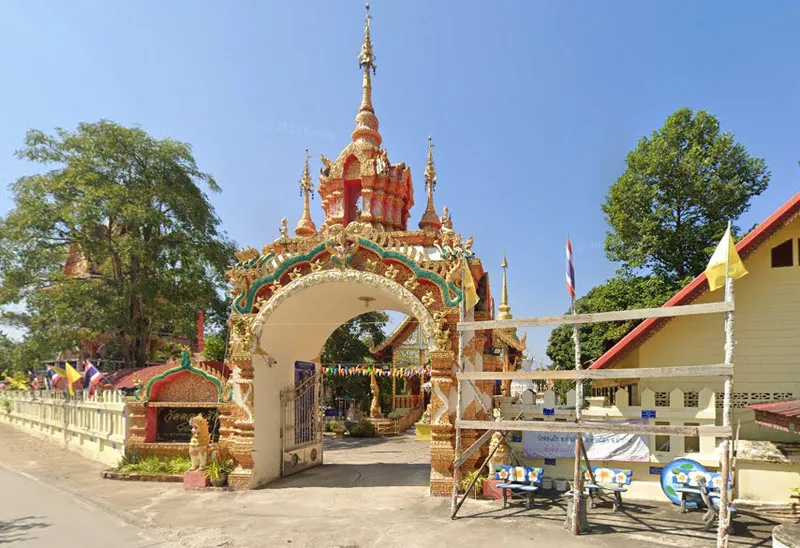Wat Don Sak

Rating: 3.8/5 (8 votes)
Lampang attractions
Attractions in Thailand
Operating day: Daily
Operating time: 08.00 - 17.00
Wat Don Sak is located at 114 Moo 5, Pae Don Sak, Hang Chat Subdistrict, Hang Chat District, Lampang Province, 52190. It belongs to the Mahanikaya sect of Thai Buddhism. The temple land spans 1 rai, 1 ngan, and 3 square wah.
Formerly, it was known as Wat Nong Bua Tong. According to oral tradition passed down through generations, the temple had been relocated two or three times, mainly in search of better water sources and to escape drought-stricken areas. One of the abandoned former sites is now temple land and is used as a community waterworks area, a sports ground, and a public hall.
Eventually, the temple was moved to its current location, which was originally a forested area abundant with teak trees, situated on elevated land. Locals referred to the place as "Don Pa Sak" (teak forest hill). When the temple was completed, it was named "Wat Don Sak" and it has been known by that name ever since.
The land was initially a scrubland owned by a man named Ta, who donated it to be temple property. The construction of the temple began around 1907 (B.E. 2450).
Currently, Wat Don Sak occupies 4 rai, 2 ngan, and 65 square wah. At the beginning, under the leadership of village headman Ta, the temple had only small monk huts without a vihara. The temple grounds were enclosed by a simple wooden fence.
In 1917 (B.E. 2460), Phra Athikan Wong became the abbot, overseeing a monastic community consisting of one monk and fifteen novices. In 1930 (B.E. 2473), under the support of village headman Wai, a vihara was constructed at a cost of 7,000 baht. In 1933 (B.E. 2476), Phra Athikan Pun became the abbot, with two monks and nineteen novices, while the village was led by headman Ku. Later, under headman Saen Ta Chai, a boundary wall was built around the temple in 1936 (B.E. 2479) at a cost of 14,000 baht and 25 satang.
The temple is bounded to the north by about 120 wa of rice fields, to the south by about 150 wa along a public road, to the east by about 130 wa of rice fields, and to the west by about 160 wa along another public road. There is also one plot of temple land, measuring 3 rai and 1 ngan.
Structures within the temple include a Lanna-style ordination hall (ubosot), a sermon hall, and monk residences. The principal Buddha image, constructed in 1897 (B.E. 2440), remains a revered sacred object within the temple.
The temple was officially granted its ordination boundary (wisungkhamsima) on April 30, 1979 (B.E. 2522), with a designated area of 20 meters in width and 40 meters in length.
Since its founding, the temple has had eight abbots: Phra Moi (1897–1912), Phra Tip (1913–1915), Phra Apiwong Chayananyo (1916–1922), Phra Kaew Katapunyo (1923–1929), Phra Ma Yanawichayo (1930–1937), Phra Hon Chanthasubho (1938–1953), Chao Athikan Sao Thawaro (1954–1976), and from 1976 to the present, Phra Khru Sukham Sirimongkolo.
Comment
| Keyword (Advance) |
 Facebook Fanpage
Facebook Fanpage

 Category:
Category:  Group:
Group:  Art, Culture and Heritage
Art, Culture and Heritage Historical Sites and Monuments(
Historical Sites and Monuments( Landmarks and Memorials(
Landmarks and Memorials( Art, Craft Centres, Tradition(
Art, Craft Centres, Tradition( Museums(
Museums( Historical Houses and The Ancient City(
Historical Houses and The Ancient City( University
University Other religious and spiritural sites(
Other religious and spiritural sites( Research and Development
Research and Development Royal Project(
Royal Project( Suburban Living
Suburban Living Village, Community(
Village, Community( Local Market(
Local Market( Nature and Wildlife
Nature and Wildlife National Parks and Marine Reserves(
National Parks and Marine Reserves( Mountain (Doi)(
Mountain (Doi)( Dam, Reservoir, Lake(
Dam, Reservoir, Lake( Waterfalls(
Waterfalls( Hot Springs(
Hot Springs( Caves(
Caves( Flower Field(
Flower Field( River, Canal(
River, Canal( Bays and Beaches(
Bays and Beaches( Other natural attractions(
Other natural attractions( Entertainment and Agricultural
Entertainment and Agricultural Animal camps and shows(
Animal camps and shows( Farm, Parks, Gardens and Ecotourism(
Farm, Parks, Gardens and Ecotourism( Outdoor and Adventure Activities(
Outdoor and Adventure Activities( Shopping
Shopping Shopping and Night Market(
Shopping and Night Market( Spas and Wellness
Spas and Wellness Spas and Wellness(
Spas and Wellness(